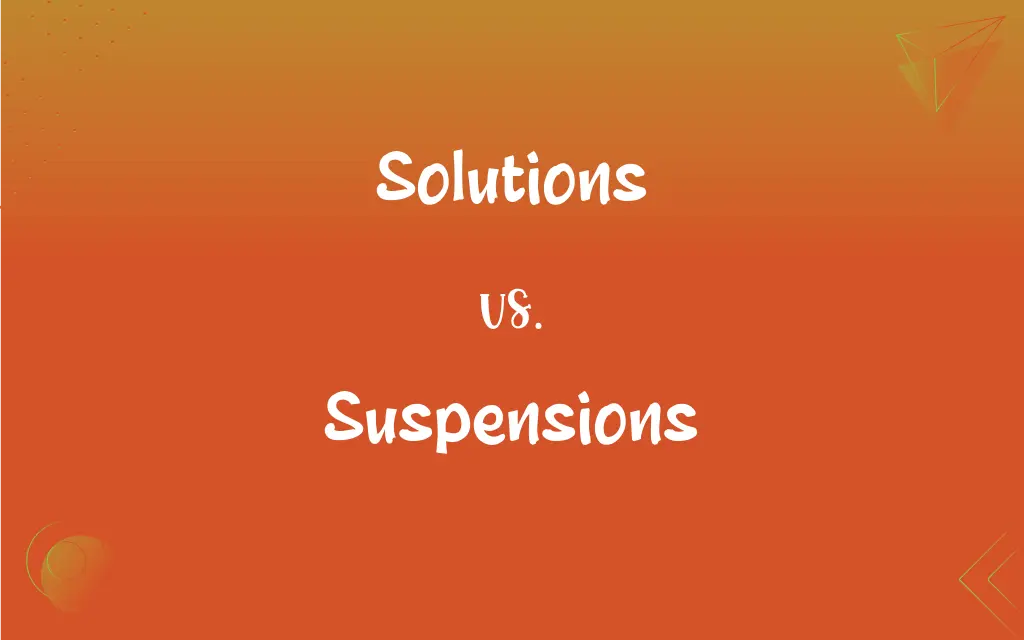Solutions vs. Suspensions: What's the Difference?
Edited by Aimie Carlson || By Harlon Moss || Updated on October 21, 2023
Solutions are homogeneous mixtures with solute particles dissolved; suspensions have larger particles that settle out if not agitated.

Key Differences
Solutions represent a type of mixture in which the solute is fully dissolved in the solvent, leading to a consistent and uniform composition throughout. Suspensions, on the other hand, consist of particles that are larger and don't dissolve but remain dispersed throughout the medium. These particles can settle out over time.
In the realm of clarity, solutions are typically clear and allow light to pass through without scattering. Suspensions often appear cloudy or opaque due to the light being scattered by the undissolved particles. If you were to shine a beam of light through both, the beam would pass straight through solutions, while in suspensions, the path of the beam would be visibly disrupted.
On the topic of particle size, solutions possess very small particles—often at the molecular or ionic level—making them undetectable by ordinary means. Suspensions carry larger particles that are often visible and can be filtered out using common filtration methods.
From a stability standpoint, solutions don't separate into different layers over time since the solute remains dissolved. Suspensions, contrastingly, are unstable in nature. The particles within suspensions, being undissolved, tend to settle at the bottom if the suspension is left undisturbed for an extended period.
Considering the behavior when left alone, solutions are stable and don't need any agitation to maintain their uniformity. Suspensions, due to their inherent instability, need occasional stirring or shaking to prevent the particles from settling.
ADVERTISEMENT
Comparison Chart
Homogeneity
Homogeneous mixture where solute is fully dissolved.
Heterogeneous mixture with larger undissolved particles.
Clarity
Typically clear, allowing light to pass without scattering.
Cloudy or opaque, scattering light.
Particle Size
Very small, often molecular or ionic, undetectable by ordinary means.
Larger, visible, and can be filtered out.
Stability
Do not separate into different layers over time.
Particles settle out if left undisturbed.
Behavior When Left Alone
Stable and remain uniform without any need for agitation.
Need stirring or shaking occasionally to maintain dispersion.
ADVERTISEMENT
Solutions and Suspensions Definitions
Solutions
Stable mixtures that won't separate upon standing.
The components of a solution of ethanol and water remain mixed without settling.
Suspensions
Often cloudy or opaque due to the size of the dispersed particles.
A suspension of chalk in water will appear milky.
Solutions
Often clear liquids that allow light to pass through.
Metallic solutions are clear but can have varying colors based on the metal.
Suspensions
Mixtures where particles can settle out if not continuously agitated.
Orange juice with pulp is a suspension, and the pulp can settle at the bottom.
Solutions
Characterized by uniform composition throughout.
In a solution of vinegar and water, each sip tastes the same due to its uniformity.
Suspensions
Particles can often be separated by filtration.
The particles in a muddy water suspension can be filtered out using a fine mesh.
Solutions
Mixtures where solutes are completely dissolved in solvents.
In a sugar solution, sugar crystals disappear to form a clear liquid.
Suspensions
Heterogeneous mixtures with visible undissolved particles.
Sand in water creates a suspension that clears once the sand settles.
Solutions
Homogeneous mixtures of two or more substances.
Saltwater is one of the most common solutions we encounter.
Suspensions
Require agitation to maintain a uniform dispersion of particles.
Suspensions of some medications need to be shaken well before use.
Solutions
A method or process of dealing with a problem
Sought a solution to falling enrollments.
Suspensions
An interruption or temporary cessation, as of an activity or of the application of a rule or law.
FAQs
Can gases form solutions?
Yes, gases can dissolve in other gases to form solutions, e.g., air is a solution of various gases.
What is a solution?
A solution is a homogeneous mixture of two or more substances, where one substance (the solute) is uniformly distributed within another substance (the solvent).
How is a solution different from a suspension?
Unlike suspensions, solutions are homogeneous and the solute particles cannot be separated by settling or filtration.
What are aqueous solutions?
Aqueous solutions are solutions where water acts as the solvent.
Can the concentration of a solution be changed?
Yes, the concentration can be changed by adding or removing the solute or solvent.
What happens if a suspension is left undisturbed?
The particles in a suspension can settle to the bottom over time.
What factors affect solubility?
Temperature, pressure, and the nature of solute and solvent can affect solubility.
What is solubility?
Solubility is the maximum amount of a solute that can dissolve in a given amount of solvent at a specific temperature.
Do all solutes dissolve in all solvents?
No, solubility depends on the nature of both the solute and solvent. For example, oil does not dissolve in water.
How can a suspension be re-dispersed?
Stirring or shaking can redistribute the particles throughout the suspension.
Why don't particles in suspensions dissolve?
The particles are not molecularly dispersed and might be insoluble in the medium they are in.
How can one separate particles from a suspension?
Methods like filtration, sedimentation, or centrifugation can be used to separate particles from suspensions.
Can a suspension be clear?
No, suspensions are usually cloudy or opaque because of the undissolved particles.
Can the particle size affect a suspension?
Yes, larger particles settle more quickly than smaller ones.
What is a solvent?
The solvent is the component of a solution that is present in the largest amount and dissolves the other component(s).
What is a solute?
The solute is the component of a solution that gets dissolved in the solvent.
How do suspensions differ from solutions?
Suspensions are heterogeneous and the particles can settle upon standing or be filtered out, unlike solutions.
What is the difference between a suspension and a colloid?
Particle size distinguishes them. In colloids, particles are smaller than in suspensions but larger than in true solutions.
Can gases form suspensions?
Yes, solid or liquid particles can be suspended in gases, like in smoke or mist.
About Author
Written by
Harlon MossHarlon is a seasoned quality moderator and accomplished content writer for Difference Wiki. An alumnus of the prestigious University of California, he earned his degree in Computer Science. Leveraging his academic background, Harlon brings a meticulous and informed perspective to his work, ensuring content accuracy and excellence.
Edited by
Aimie CarlsonAimie Carlson, holding a master's degree in English literature, is a fervent English language enthusiast. She lends her writing talents to Difference Wiki, a prominent website that specializes in comparisons, offering readers insightful analyses that both captivate and inform.































































